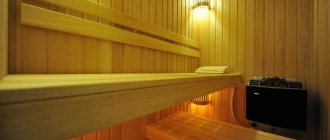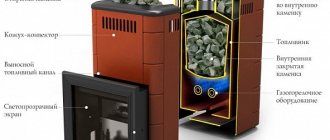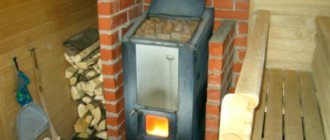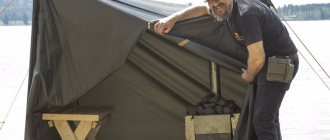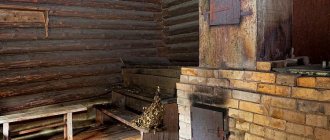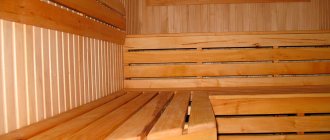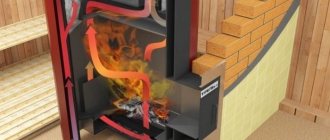The traditional way to heat a Russian bath is a heater stove. It occupies a central place in the room and provides the necessary heating, steam formation, and creates a specific microclimate and aroma in the bathhouse. At the same time, the term “heater stove” itself denotes a huge group of varieties and models.
In practice, it combines all types of sauna stoves equipped with a special design element. Such stoves are found in private and public baths; they are an obligatory element of the steam room, its integral part. Let's take a closer look at this issue.
5/5 — (1 vote)
What is a heater
In the minds of untrained people, a heater stove is a heating structure built of stone. In their opinion, this follows from the name itself. However, this idea is erroneous and has nothing to do with reality.
A heater stove is the collective name for all stoves used in a bathhouse and equipped with the same structural element - a heater. It is this detail that determines whether the stove belongs to the group under consideration. At the same time, the design itself, the type of fuel and other features of the heating structure do not matter in this case.
A heater is an element of a stove, a kind of thermal energy accumulator. It is a pile of stones placed in a special open or closed compartment. The mass of stones is large enough to radiate thermal energy into the room for some time after the completion of the kindling.
When the stove is lit, the stones heat up and accumulate thermal energy. The greater the mass of stones, the longer the heating, but the heat reserve will be much higher.
Another task of the heater is steam generation. It is on the stones that they throw water from the ladle when they want to add steam. For some models, this method allows you to protect the case from sudden cooling and cracking. For example, metal stoves without a heater cannot be used to supply steam, only as heating elements.
Design Features
A sauna heater is a regular stove, to which is attached a special compartment with stones placed in it. Typically, river or sea pebbles are used, as well as medium-sized fragments (5-7 cm). Not only do they have enough mass to store heat, but they can also be laid quite tightly and without too many voids between individual stones.
In addition to size, the type of stone backfill plays an important role. As a rule, they use rocks available near the location of the bathhouse.
However, experts prefer to use certain rocks as a filler - it is believed that each type of stone has its own properties and can change the quality of bath procedures.
The stone compartment can be a kind of basket made of a steel strip mounted on the side or on top of the firebox. The location of the heater is determined by the overall design of the stove - if there is a water tank, the heater is installed on the side, and if there is none, on top, above the firebox.
It is noteworthy that there are also reverse options, when the tank is on the side and the heater is on top.
The design of the heater is very simple and does not contain any mechanical parts. It is not difficult to assemble it yourself. The main task will be to select suitable stones and correctly place them close to the wall or top of the firebox.
If the furnace itself is metal, it is necessary to install a cutoff - a steel sheet laid between the hot body and the stones. It will protect the furnace from sudden cooling and possible destruction. On brick stoves, the heater compartment is an element of the masonry and is built together with the main structure.
EasyStim ovens
These units are made from stainless steel 4-6 millimeters thick, the chromium content in them is 17%. In order to reduce the number of welds, the firebox and container for stones are formed by stamping and bending. To strengthen the walls of the firebox, special stiffening ribs are used, and to improve the heating of the stones and reduce the load on the bottom, it is made round in shape.
To prevent flames from entering the chimney, a flame breaker is installed in the firebox. The chimney channel is curved in order to more efficiently use the energy obtained during the combustion process. As a result, the flue gases go around the container filled with stones from all sides, which leads to their high-quality heating.
In order to regulate the operation, there is a handle at the top of the unit that changes the location of the thermostat damper. When the gap is open, intense heating of the room occurs, and if it is closed, the stones are heated.
Such closed-type sauna stoves have steam generators installed inside, namely systems consisting of tubes with holes that are located in the heater. The water that enters there falls on highly heated stones, and is then distributed over a large area due to the presence of a system of holes.
The water begins to evaporate, falling on the hot stones. The steam that is formed rushes up, bypassing the stones towards the outlet located above. As a result, the steam is broken into small particles, heats up more and becomes almost transparent.
Advantages and disadvantages
The advantages of a heater stove include:
- a wide variety of design options;
- any type of stove can be used as a heat source;
- uniform and high-quality heating of the room;
- simplicity and reliability of design;
- you can replace stones in order to get a certain effect from bath procedures;
- The steam quality is very high. At the same time, you can get dry or wet steam, depending on the type of heater;
- it is possible to adjust the distribution of thermal energy within certain limits by changing the number of stones in the compartment;
- A heater stove can be purchased as a ready-made design, or you can make it yourself.
Flaws:
- heating stones requires time and fuel consumption;
- The heater has great thermal energy. It is almost impossible to cool it quickly and sharply;
- the weight of the stones creates an additional load, which may require its own independent foundation;
- It is impossible to increase the size of the heater if the power of the stove is not enough to heat such a mass.
The disadvantages of the heater can be considered design features. They are dictated by the physical properties of the backfill material and are a direct consequence of the very principle of operation of the structure.
However, despite the shortcomings, a heater stove is considered the best option for arranging a Russian bath. The vast majority of baths are equipped with similar stoves, and the absence of a heater is simply unacceptable for many users.
Varieties
There are many types of heater stoves. In fact, any stove can be classified as such if it is equipped with a compartment for placing stones. Furnaces are divided according to different criteria.
First of all, by type of firebox:
brick
steel
cast iron
combined
- Brick ovens are safe and easy to use. However, they require a long warm-up period, which means high fuel consumption. At the same time, a heated brick oven is able to retain heat for a long time, which is not observed when using metal ovens.
- Metal stoves , on the contrary, heat the room quickly and economically. However, they cool down just as quickly, and only a massive heater can stop this process.
- Combination stoves are a combination of a cast iron or steel firebox with a brick body, or a brick firebox on which a steel water tank is installed and a compartment for stones on the side. This design option is very common.
By type of heater:
open
The stones are in plain sight (laid in a mesh or basket made of steel strips);
closed
The stones are located in a closed section. Access to them for water supply is made through a special hatch or door.
It is generally accepted that open heaters produce more humid steam, and closed heaters produce drier steam.
By fuel type:
wood (or solid fuel)
gas
electric
liquid fuel
The traditional option is a wood stove. However, in terms of efficiency and heating speed, a gas furnace is the leader.
Electric designs practically do not lag behind gas ones - they do not require monitoring and constant supply of fuel, and allow you to precisely adjust the heating mode. However, in regions with expensive electricity, the use of heating elements costs too much.
Liquid fuel stoves are powered by hydrocarbon fuel compositions - gasoline, diesel fuel, kerosene, etc. They are quite effective, but the fuel will have to be stored somewhere, which in itself requires special measures.
By operating mode:
long burning
As a rule, these are brick ovens that can be fired continuously as long as fuel is available;
periodic combustion
Typically, these are metal stoves (steel or cast iron), which are heated only for a certain time.
The first group of stoves is characterized by durability and the ability to accumulate and gradually release heat, ensuring uniform heating of the room. The second group is valued for its ability to quickly warm up the room and save time for the bathhouse owner. However, after the end of the kindling, the temperature in the bathhouse quickly drops.
Design features.
Stove for baths and saunas Laguna 12 TK
The Laguna series includes several sauna stoves with a vertically positioned closed heater. Models differ from each other in such a parameter as the volume of the steam room for which they are intended to warm up. The greatest demand is for 12 TK, designed for heating steam rooms with a volume of 6-12 m3.
Firewood is used as fuel, and the size of the firebox allows the use of logs up to 40 cm long. The weight of 12 TK is only 58 kg, of which 17 kg weigh directly from the stones, so there is no need to equip the foundation.
The stove is equipped with a chimney with a pipe diameter of 11.5 cm. Water is supplied to the stones using a special device, which is very convenient and safe.
The body and firebox of such stoves are made of high-quality sheet steel, and the panoramic door is made of heat-resistant glass.
Stove for baths and saunas Kuban-Panorama 20L
The Kuban series of sauna stoves includes combined models that operate not only on solid fuel, but also on gas. In addition, an equally important point is the combination of two types of heaters in one device - closed and open. As a result, the stoves in this line organically combine the advantages of the two varieties, minimizing some of their inherent disadvantages.
Among the wood-burning stoves of the Kuban series, the 20L model stands out, designed for a steam room of a fairly large volume - up to 20 cubic meters. m. Its design includes a convection heating mechanism, and the body is made of high-strength stainless steel. In the manufacture of the firebox, high-alloy steel is used, which contains up to 13% chromium, and for the parts of the furnace that are most exposed to thermal effects, steel is used, which contains up to 17% chromium. The warranty for this stove is 3 years.
Some models combine open and closed heaters in their design and allow you to obtain light steam of excellent quality.
A distinctive feature of the Siesta series of stoves is that they can be used not only for a bath, but also as a home fireplace. A large panoramic glass makes it possible to observe the play of flames in the firebox, which creates a special atmosphere. This oven can also be used for barbecuing. Thanks to the “Anti-smoke” option, patented by the manufacturer in Russia, the stove does not smoke even when the door is open.
The device is highly powerful; with its help you can not only heat up the steam room, but also heat the rest room and even the second floor of the bathhouse building. Thus, one such stove is enough to heat the entire building.
The Kuzbass Optima series stoves combine open and closed heaters in their design and produce light steam of excellent quality. To supply water, a built-in dispenser is used, which is located on a decorative frame.
Types of stones
Since the heater as a stove element is a volumetric storage of stones heated by the heat of the firebox and used as a steam generator, it is of great importance what rocks are used to perform these tasks.
Expert opinion
Lovkachev Boris Petrovich
Bath master who knows everything about steaming
It is necessary to immediately take into account that it is rocks of igneous origin that are required. Sedimentary types - limestone, sandstone, etc. - will not work.
Due to sudden temperature changes when heating and supplying water to create steam, such stones will quickly crumble into sand. In addition, these stones are too loose and do not have sufficient heat capacity (cool quickly).
Among connoisseurs, the following breeds are most preferred:
basalt
This is solidified lava that erupted from a volcano. It is considered the best option for a bath. There are subtypes of basalt - dolerite, anamesite, diabase;
nephritis
The most durable stone - even under conditions of daily use, it retains its working qualities for up to 10 years;
jasper
The best option for a bath is wax jasper, which has a uniform structure. It is not recommended to choose multi-colored (beautiful) jasper, as it can be destroyed due to the difference in thermal destruction of the layers;
gabbro-diabase
A good and inexpensive stone for a bathhouse, capable of maintaining working qualities for a long time. It is necessary to choose stones without sulfites so that they do not emit any odors when heated;
blows
This rock is formed at great depths under high pressure conditions, which makes the stone strong, durable and heat-intensive. Suitable for the bottom of the heater and for filling the entire compartment;
jade
A very good stone for a bath. There are many legends about him, but many of them turn out to be reality when tested. This type of stone rarely comes to the surface, therefore, jadeite is expensive.
It is not recommended to use:
granite
This stone is completely unsuitable for a bathhouse, as it has a grainy structure and quickly begins to crumble;
white quartz
It is credited with a lot of beneficial properties - skin rejuvenation, air ozonation. However, these are all myths. White granite quickly collapses and is practically unsuitable for use in a bathhouse;
coil
This is a stone that is sold by many companies. Various healing qualities are attributed to it, but you should not purchase a coil - it does not possess any useful qualities and is completely unsuitable for use in a heater.
You should choose a stone based on the basic requirements:
- high hardness, density;
- homogeneous structure, absence of inclusions;
- medium size, the ability to tightly pack stones in the compartment.
If the stones are heavy, have a uniform color and split with great difficulty (or do not split at all), then they can be used for a heater.
Variegated beautiful stones should be discarded immediately - they will quickly crumble. In addition, we must remember that some rocks emit radiation, therefore, it is recommended to choose the material meticulously and carefully.
Popular manufacturers
You can purchase a finished heater only in a certain design. These can be steel or cast iron models, since brick heaters are built directly on site and are not found on sale.
Among the most famous manufacturers of cast iron stoves are the following companies:
Hephaestus
Etna
Inzhkomcenter VVD
Vesuvius
These are domestic manufacturers offering models with the optimal combination of price and performance characteristics.
Among the companies supplying steel furnaces to the market, the following should be highlighted:
Termofor
Teplodar
Ermak
Varvara
The stove models manufactured by these companies are durable and made of thick metal. They do not burn out for a long time and allow you to heat rooms quickly and efficiently.
As you can see, only domestic companies are listed. This was done deliberately, since these companies offer very high-quality, competitive products. At the same time, the cost of their stoves is significantly lower than that of imported analogues, which determines the choice of buyers.
useful links
A cast iron stove with a closed heater is the subject of a separate analysis in this article.
You can read about the stove for a Russian bath with a closed heater here.
Another of our materials is devoted to a brick stove.
*** If you still have questions that you haven’t found answers to, write comments and don’t hesitate to use the search - we have a lot of good articles.
How to choose a heater for a bath
Choosing a heater stove is always an individual undertaking. It is impossible to recommend one model or another here, since all baths have a different set of needs.
When purchasing a heater stove, you should pay attention to its parameters:
power . It is not necessary to consider it in kilowatts. Usually they indicate what size rooms this model is intended for;
size and weight of the heater . The larger it is, the more uniform the heating. However, if the total weight of the stove and stones exceeds 700 kg, you will have to make your own foundation;
fuel type This is an important point, since the efficiency of the furnace and the amount of upcoming costs depend on it;
presence and location of a water tank;
the presence of additional functions (remote firebox, length of firewood, etc.).
When going to the store, you need to check the dimensions of your bath and specify all the necessary data. This will help you consider the characteristics of the models in detail and choose the most suitable option.
Buying a sauna stove - which one to choose and what does the price say?
Attention, a solid price does not always indicate excellent quality. The amount may be overestimated due to the popularity of the manufacturer or due to the fact that the model has just entered the market and is a new product, a fresh hit of the season.
But the low price tag should immediately alert you. Usually it is a characteristic feature:
- made from not the highest quality material;
- too thin walls of the body/firebox;
- minimum configuration;
- execution using obsolete technology.
So you shouldn’t blindly chase after cheapness - excessive savings may result in the need to prematurely replace heating equipment.
We tried to comprehensively review sauna stoves; the review includes all the important parameters of their choice - decide, buy, install, use and enjoy your health.
Questions and answers
Choosing a heater stove is a complex procedure, during which various questions may arise. Let’s answer the most common ones that arise for almost all users:
What is better, buy a heater or make it yourself?
If you have experience and certain knowledge, you can make a stove yourself. Moreover, some stoves (brick) are not sold ready-made. However, there are designs that you can only buy - these are cast iron heaters.
How to check whether stones emit radiation?
Radiation is a serious problem in many igneous rocks. You can check them using a portable counter. The average rate is 0.3 µSv/h (microsievert per hour). If the stones “sound” more strongly, it is better not to use them.
Which type of fuel is more profitable?
Experienced users recommend gas ovens. They do not require constant monitoring and replenishment of fuel in the firebox; they heat the room, water and heater most efficiently. However, for some hobbyists, the only possible option is wood-burning stoves, like the traditional type of sauna stove.
Which heater size is more practical?
Massive heaters give off heat longer, but require longer heating. At the same time, it is large heaters weighing 100-150 kg that are valued among specialists. They provide even heating and produce good, even steam.
Is it necessary to bring the mouth of the firebox into the common room of the bathhouse, or can it be placed in the steam room?
It is better to remove it so that there is no smoke or carbon monoxide in the steam room. Ideally, only the heater compartment should go into the steam room. However, if the space is small and the configuration of the bath does not allow it to be located outside the steam room, the stove is installed in the manner that is possible.
Steam gun
The operation of a closed heater depends on how isolated it is from the walls of the unit and the state of the air in the steam room. The better these indicators are, the hotter the stones will be able to heat up. However, in this case there is a problem with how to supply water to the stones.
In order to obtain steam inside the heater, a system of tubes with holes is installed. A glass or funnel is attached to the outside and water is poured in. It flows down the tube down the unit. Such a device is called a heat gun. It got its name because the escaping steam makes loud sounds, reminiscent of a gunshot.
When using this device, it is recommended not to limit yourself to a single tube - it is better to make a branched version at the bottom, which will evenly distribute the liquid throughout the stove and bring it to the hottest zones.
Good light steam is finely dispersed steam that is formed in a split second. You can only get it from very hot stones. If you splash water on stones that are not hot enough, the moisture from them will evaporate slowly, and a damp fog will hang in the steam room, difficult for a person’s lungs to tolerate.
Since the stones at the bottom of the pile, in contact with the combustion chamber, are the hottest, this is where I would like to splash some water, but how? By installing a steam gun or steam generator.
Its designs may be different, but the essence is the same - it is a pipe, the upper part of which rises above the stove, and the bottom goes deep into the stone pile. At the end there may be branches and holes through which water is supplied.
Steam generator for a bath
The device received the name “gun” for its muzzle-shaped shape and the clap, like a shot, with which steam escapes.
Many manufacturers produce guns of a certain model that fit their boilers. But you can make a device from scrap materials with your own hands.
The best models of generation guns go down to the very bottom of the pile and have a valve at the top that will prevent the steam, while still heavy, from escaping through the top of the pipe. Moisture should rush down to the bottom of the heater and, passing through the holes, wash the stones, and only then enter the room.
If you apply water with the addition of sea salt to hot stones, the steam will be hotter and will also have a disinfecting effect. It is best to feed boiling water into a steam cannon.
